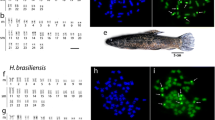Abstract
Cichlidae is the most species-rich freshwater family of Perciformes and has attracted the attention of aquarium hobbyists, aquaculturists, and sport fisherman. Oreochromis niloticus is very important in aquaculture today and is currently used in varied areas of study as an ‘experimental model’. Oreochromis niloticus has been characterized using classical and molecular cytogenetic techniques, with special attention paid to heterochromatin structure and the identification of sex chromosomes. In this study, we compare the genome of O. niloticus with that of other cichlids from Africa and South America using genomic in-situ hybridization (GISH). Our results show that at least some elements comprising the pericentromeric heterochromatin of Nile tilapia are species-specific and that the sequence of the majority of the long arm of the largest chromosome pair is conserved within the tilapiine group, which is composed of the genera Tilapia, Oreochromis, and Sarotherodon. It is suggested that the extensive regions of repeated DNA in the largest chromosome pair of O. niloticus resulted from chromosome rearrangement or accumulation caused by recombination suppression during the evolutionary history of the tilapiines.



Similar content being viewed by others
Abbreviations
- 2n:
-
diploid number
- BAC:
-
bacterial artificial chromosome
- C buffer:
-
coupling buffer
- Cot-1 DNA:
-
DNA enriched for highly and moderately repetitive DNA sequences
- FISH:
-
fluorescence in-situ hybridization
- FITC:
-
fluorescein isothiocyanate
- GISH:
-
genomic in-situ hybridization
- LINE:
-
long interspersed nuclear elements
- m/sm:
-
meta-submetacentric chromosome
- NCBI:
-
National Center for Biotechnology Information
- SINE:
-
short interspersed nuclear elements
- SSC:
-
standard saline citrate
- st/a:
-
subtelo-acrocentric chromosomes
- st:
-
subtelocentric chromosomes
- Tc1:
-
transposon of Caenorhabditis elegans
References
Bertollo LAC, Takahashi CS, Moreira-Filho O (1978) Cytotaxonomic consideration on Hoplias lacerdae (Pisces, Erythrinidae). Braz J Genet 1:103–120
Carrasco LAP, Penman DJ, Bromage N (1999) Evidence for the presence of sex chromosomes in the Nile tilapia (Oreochromis niloticus) from synaptonemal complex analysis of XX, XY and YY genotypes. Aquaculture 173:207–218
Charlesworth B, Sniegowski P, Stephan W (1994) The evolutionary dynamics of repetitive DNA in eukaryotes. Nature 371:215–220
Chew JSK, Oliveira C, Wright JM, Dobson MJ (2002) Molecular and cytogenetic analysis of the telomeric (TTAGGG)n repetitive sequences in the Nile tilapia, Oreochromis niloticus (Teleostei: Cichlidae). Chromosoma 111:45–52
Cnaani A, Lee B-Y, Zilberman N et al (2008) Genetics of sex determination in tilapiine species. Sex Dev 2:43–54
Csink AK, Henikoff S (1998) Something from nothing: the evolution and utility of satellite repeats. Trends Genet 14:200–204
FAO (2006) World aquaculture production of fish, crustaceans, mollusks, etc., by principal species in 2006. ftp://ftp.fao.org/fi/stat/summary/a-6.pdf. Accessed 13 April 2009
Farias IP, Ortí G, Sampaio I, Schneider H, Meyer A (1999) Mitochondrial DNA phylogeny of the family Cichlidae: monophyly and fast molecular evolution of the Neotropical assemblage. J Mol Evol 48:703–711
Farias IP, Ortí G, Meyer A (2000) Total evidence: molecules, morphology, and the phylogenetics of cichlid fishes. J Exp Zoolog B Mol Dev Evol 288:76–92
Farias IP, Ortí G, Sampaio I, Schneider H, Meyer A (2001) The Cytochrome b gene as a phylogenetic marker: the limits of resolution for analyzing relationships among cichlid fishes. J Mol Evol 53:89–103
Feldberg E, Porto JIR, Bertollo LAC (2003) Chromosomal changes and adaptation of cichlid fishes during evolution. In: Val AL, Kapoor BG (eds) Fish adaptations. Science Publishers, Enfield, NH, pp 295–308
Ferreira IA, Martins C (2008) Physical chromosome mapping of repetitive DNA sequences in Nile tilapia Oreochromis niloticus: evidences for a differential distribution of repetitive elements in the sex chromosome. Micron 39:411–418
Fishelson L (1988) Behaviour and gonadal structure of intergenic (Oreochromis-Sarotherodon) tilapia hybrids. In: Pullin RSV, Bhukaswan T, Tonguthai K, Maclean JL (eds). Proceedings of The Second International Symposium on Tilapia in Aquaculture, pp 159–167
Genner MJ, Turner GF (2005) The mbuna cichlids of Lake Malawi: a model for rapid speciation and adaptive radiation. Fish Fish 6:1–34
Grewal SIS, Jia S (2007) Heterochromatin revisited. Nat Rev Genet 8:35–46
Griffin DK, Harvey SC, Campos-Ramos R et al (2002) Early origins of the X and Y chromosomes: lessons from tilapia. Cytogenet Genome Res 99:157–163
Haaf T, Willard HF (1997) Chromosome-specific alpha-satellite DNA from the centromere of chimpanzee chromosome 4. Chromosoma 106:226–232
Harvey SC, Campos-Ramos R, Kennedy DD et al (2002) Karyotype evolution in Tilapia: mitotic and meiotic chromosome analysis of Oreochromis karongae and O. niloticus X O. karongae hybrids. Genetica 115:169–177
Harvey SC, Boonphakdee C, Campos-Ramos R et al (2003) Analysis of repetitive DNA sequences in the sex chromosomes of Oreochromis niloticus. Cytogenet Genome Res 101:314–319
Heinrich W (1967) Untersuchungen zum Sexualverhalten in der Gattung Tilapia (Cichlidae, Teleostei) und bei Artastarden. Z Tierpsychol 24:684–754
Hulata G, Wohlfarth G, Rothbard S (1983) Progeny-testing selection of tilapia broodstocks producing all-male hybrid progenies—preliminary results. Aquaculture 33:263–268
Hulata G, Wohlfarth GW, Karplus I et al (1993) Evaluation of Oreochromis niloticus X O. aureus hybrid progeny of different geographical isolates, reared under varying management regimes. Aquaculture 115:253–271
International Cichlid Genome Consortium (2006) Genetic basis of vertebrate diversity: the cichlid fish model. Available at http://cichlid.umd.edu/CGCindex.html. Accessed 14 July 2009
Jaillon O, Aury J-M, Brunet F et al (2004) Genome duplication in the teleost fish Tetraodon nigroviridis reveals the early vertebrate proto-karyotype. Nature 431:946–957
Kasahara M, Naruse K, Sasaki S et al (2007) The medaka draft genome and insights into vertebrate genome evolution. Nature 447:714–719
Kocher TD (2004) Adaptive evolution and explosive speciation: the cichlid fish model. Nature 5:288–298
Kornfield IL, Ritte U, Richler C, Wahrman J (1979) Biochemical and cytological differentiation among cichlid fishes of the Sea of Galilee. Evolution 33:1–14
Kullander SO (1998) A phylogeny and classification of the South American Cichlidae (Teleostei: Perciformes). In: Malabarba LR, Reis RE, Vari RP, Lucena ZM, Lucena CAS (eds) Phylogeny and classification of neotropical fishes, 5th edn. EDIPUCRS, Porto Alegre, pp 461–498
Kullander SO (2003) Family Cichlidae. In: Reis RE, Kullander SO, Ferraris CJ (eds) Check list of the freshwater fishes of South and Central America. EDIPUCRS, Porto Alegre, pp 605–654
Lee BY, Kocher TD (2007) Exclusion of Wilms tumor (WT1b) and ovarian cytochrome P450 aromatase (CYP19A1) as candidates for sex determination genes in Nile tilapia (Oreochromis niloticus). Anim Genet 38:85–86
Lee BY, Penman DJ, Kocher TD (2003) Identification of a sex-determining region in Nile tilapia (Oreochromis niloticus) using bulked segregant analysis. Anim Genet 34:379–383
Liem KF (1991) Functional morphology. In: Keenleyside MHA (ed) Cichlid fishes: behavior, ecology and evolution. Chapman and Hall, London, pp 129–150
López-Fernández H, Honeycutt RL, Winemiller KO (2005) Molecular phylogeny and evidence for an adaptive radiation of geophagine cichlids from South America (Perciformes: Labroidei). Mol Phylogenet Evol 34:227–244
Lowe-McConnell RH (1999) Estudos ecológicos de comunidades de peixes tropicais. EDUSP, São Paulo
Majumdar KC, McAndrew BJ (1986) Relative DNA content of somatic nuclei and chromosomal studies in three genera, Tilapia, Sarotherodon, and Oreochromis of the tribe Tilapiini (Pisces, Cichlidae). Genetica 68:175–188
Meli R, Prasad A, Patowary A et al (2008) FishMap: a community resource for zebrafish genomics. Zebrafish 2:125–130
Murphy TD, Karpen GH (1998) Centromeres take flight: alpha satellite and the quest for the human centromere. Cell 93:317–320
Nelson JS (2006) Fishes of the world, 4th edn. Wiley, New York
Oliveira C, Chew JSK, Porto-Foresti F, Dobson MJ, Wright JM (1999) A LINE-like repetitive DNA sequence from the cichlid fish, Oreochromis niloticus: sequence analysis and chromosomal distribution. Chromosoma 108:457–468
Oliveira C, Wang Y, Bryden LJ, Wright JM (2003) Short interspersed repetitive elements (SINEs) from the cichlid fish, Oreochromis niloticus, and their chromosomal localization by fluorescent in-situ hybridization. Caryologia 56:177–185
Pardue ML, Gall JG (1969) Molecular hybridization of radioactive DNA to the DNA of cytological preparations. Proc Natl Acad Sci U S A 64:600–604
Pruginin Y, Rothbard S, Wohlfarth G, Halevy A, Moav R, Hulata G (1975) All-male broods of Tilapia nilotica × Tilapia aurea hybrids. Aquaculture 6:11–21
Rana KJ, McAndrew BJ, Wohlfarth G, MacGowan I (1996) Observations on intergenic hybrids in Tilapias. In: Pullin RSV, Lazard J, Legendre JB, Amon Kothias JB, Pauly D (eds) Proceedings of the Third International Symposium on Tilapia in Aquaculture. Penang, ICLARM (WorldFish Center), pp 391–397
Sambrook J, Russel DW (2001) Molecular cloning: a laboratory manual, 3rd edn. Cold Spring Harbor Laboratory Press, Cold Spring Harbor, NY
Smith WL, Chakrabarty P, Sparks JS (2008) Phylogeny, taxonomy, and evolution of Neotropical cichlids (Teleosteis: Cichlidae: Cichlinae). Cladistics 24:625–641
Solari AJ (1994) Sex chromosomes and sex determination in vertebrates. CRC Press, Boca Raton, FL
Stace CA, Bailey JP (1999) The value of genomic in-situ hybridization (GISH) in plant taxonomic and evolutionary studies. In: Hollingsworth PM, Bateman RM, Gornall RJ (eds) Molecular systematics and plant evolution. Taylor & Francis, London, pp 199–210
Svartman M, Vianna-Morgante AM (1999) Comparative genome analysis in American marsupials: chromosome banding and in-situ hybridization. Chromosome Res 7:267–275
Swofford DL (1998) PAUP*. Phylogenetic Analysis Using Parsimony (*and Other Methods). Version 4. Sinauer Associates, Sunderland, MA, 140 p
Topp CN, Dawe RK (2006) Reinterpreting pericentromeric heterochromatin. Curr Opin Plant Biol 9:647–653
Trewavas E (1983) Tilapiine fishes of the genera Sarotherodon. Oreochromis and Danakilia, British Museum (Natural History), London
Turner GF (2007) Adaptive radiation of cichlid fish. Curr Biol 17:R827–R831
Verheyen E, Salzburger W, Snoeks J, Meyer A (2003) Origin of the superflock of cichlid fishes from lake Victoria, East Africa. Science 300:325–329
Acknowledgements
The authors are grateful to FAPESP (Fundação de Amparo à Pesquisa do Estado de São Paulo), CNPq (Conselho Nacional de Desenvolvimento Científico e Tecnológico), and CAPES (Coordenação de Aperfeiçoamento de Pessoal de Nível Superior) for financial support, and to D Penman for the tissue samples provided.
Author information
Authors and Affiliations
Corresponding author
Additional information
Responsible Editor: Nobuo Takagi
Electronic supplementary material
Below is the link to the electronic supplementary material.
Supplement S1
Cichlidae species and gene sequences obtained from NCBI (http://www.ncbi.nlm.nih.gov/) used for genetic distance analyses. (PDF 39 kb)
Supplement S2
Correlation between the genetic distance among cichlid species and the percent of hybridization in the chromosomes of O. niloticus. R2 indicates the coefficient of determination. (PDF 252 kb)
Rights and permissions
About this article
Cite this article
Targino Valente, G., Henrique Schneider, C., Claudia Gross, M. et al. Comparative cytogenetics of cichlid fishes through genomic in-situ hybridization (GISH) with emphasis on Oreochromis niloticus . Chromosome Res 17, 791–799 (2009). https://doi.org/10.1007/s10577-009-9067-5
Received:
Accepted:
Published:
Issue Date:
DOI: https://doi.org/10.1007/s10577-009-9067-5




